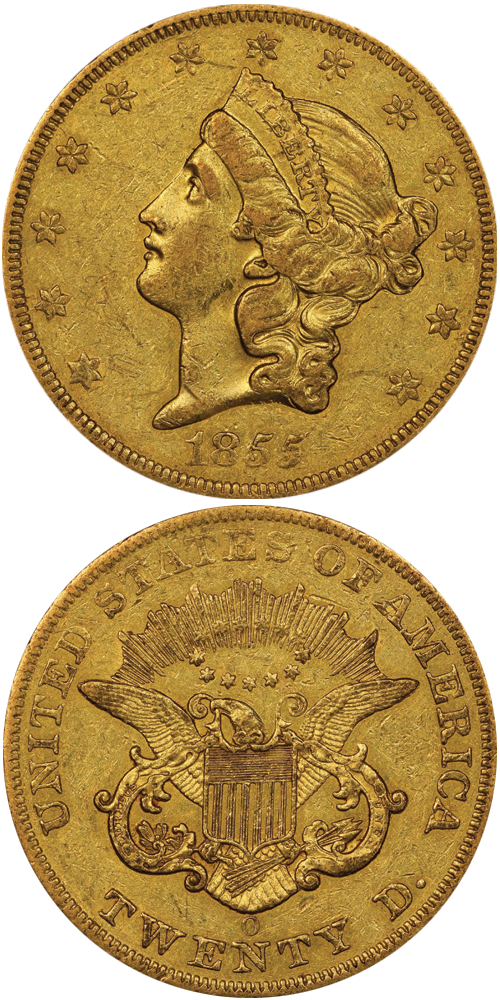1855-O Liberty Head Double Eagle
The 1855-O $20 double eagle does not match 1854-O and 1856-O in rarity, but it is certainly among the most elusive Type I issues. The obverse is a bit softer struck on average, and the reverse typically comes sharp but with a weak mintmark, which is not altogether uncommon for New Orleans mint coins. Scarce in all grades, the majority of survivors exhibit Very Fine preservation, becoming progressively scarcer up through About Uncirculated where only about a dozen pieces are thought to exist. Just two coins are currently known in Mint State; an MS-60 (NGC) and an MS-61 (NGC).
With just 8,000 pieces produced and the effects of commercial use taking their toll, the 1855-O is regarded as an important rarity among New Orleans Mint double eagles. In fact, it is the third rarest O-Mint twenty after only the legendary 1856-O and 1854-O. The extant population of the 1855-O is universally regarded as numbering fewer than 100 coins in all grades, with Doug Winter (Gold Coins of the New Orleans Mint: 1839-1909, 2006 edition) providing a more precise estimate of 70 to 80 pieces. Most survivors grade VF to EF, and opportunities to acquire an 1855-O of even marginal quality are few and far between.
It might seem strange at first glance that the New Orleans Mint produced so few double eagles in virtually every year from 1850 through the facilities' seizure by Confederate forces in 1861. After all, the Coinage Act of March 3, 1849, created the double eagle directly in response to the discovery of gold in California the preceding year. However, most gold was shipped to New York City where it was processed by the sub-Treasury with much sent to England and to the Philadelphia Mint. There was no particular reason to have double eagles coined in New Orleans with the Philadelphia Mint so close to New York.
Production started reasonably well, nonetheless, with yearly mintages of double eagles in New Orleans topping the 100,000-coin mark from 1850 to 1852. In 1851 a total of 315,000 twenties were struck, a limited number compared to the output of the Philadelphia Mint at that time (2,087,155 pieces), but it was a record for the New Orleans Mint. Beginning in 1853, however, two important events in California would severely curtail double eagle production in New Orleans through the onset of the Civil War. The first was the commencement of large scale $20 gold coin production at the United States Assay Office of Gold in San Francisco in 1853. With the ability to convert gold bullion into a high quality, widely accepted $20 gold coin so close to the mining operations, there was little need to take on the cost and risk of transporting the metal to New Orleans. Double eagle coinage in New Orleans reflected this shift in fortunes with a reduction in mintage figures from 190,000 pieces in 1852 to just 71,000 coins in 1853.
The downward spiral of double eagle production in New Orleans would continue and, in fact, steepen in 1854, caused in part by the facility being in disrepair and needing extensive renovations. From that year through 1861 and the onset of the Civil War, double eagle deliveries from the New Orleans Mint would remain below the 40,000-coin mark each year, and in 1855, 1856, 1859 and 1860 they would not even reach 10,000 pieces.
Throughout the entire era of Type I double eagle production there, problems in the New Orleans Mint also contributed to limited yearly mintage figures. Built on unstable ground that had once been river bed and remained close to the Mississippi River, the building settled and suffered significant enough wear and tear from its opening in 1838 that by 1854 the federal government began taking action to repair the facility, as noted above. Construction commenced in 1855 and continued intermittently through 1857. Additionally, the humid atmosphere and wet conditions in New Orleans brought on a yellow fever epidemic in 1853 that claimed the lives of 8,000 people in only four months.
With both local conditions and developments out West conspiring against it, it is remarkable that the New Orleans Mint produced as many double eagles as it did throughout the 1850s. In many ways conditions were nearly as rustic and challenging as those that prevailed at the Carson City Mint during its earliest years of operations in the 1870s. Like those who are attracted to the history and romance of Carson City Mint coinage, a growing number of specialists are attracted by the fascinating story of our nation's southernmost mint.
The example to the left was sold by Stack's Bowers Galleries in April 2022 as part of the Fairmont Collection, Hendricks Set, where it realized $51,600.






